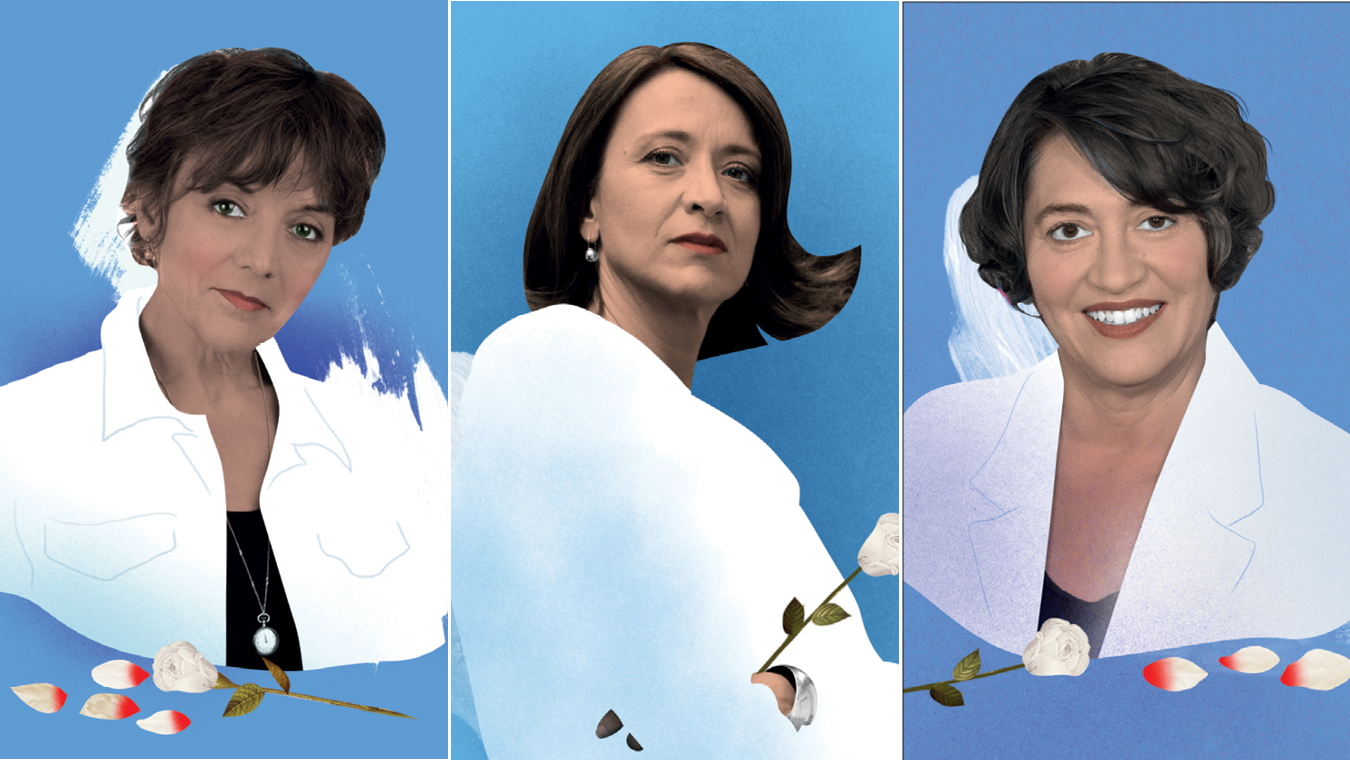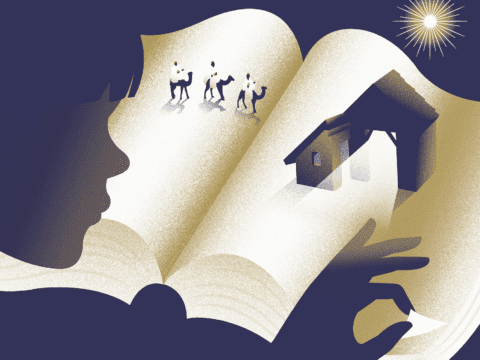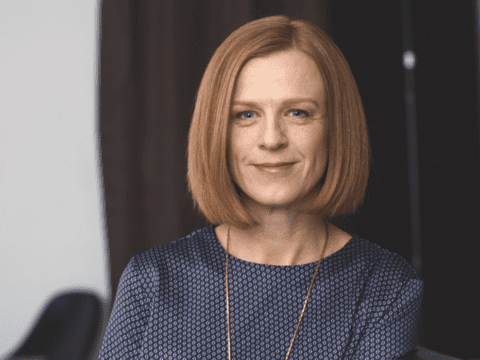Fourteen women dead. Fourteen people injured. Twenty minutes. That’s all it took for one man who hated feminists to complete his murderous rampage through the classrooms, corridors and cafeteria of Montreal’s École Polytechnique, shouting at men to get out of the way so he could hunt down women before turning the gun on himself. “Massacre” was the only way to describe it. The events of Dec. 6, 1989, are forever ingrained in our nation’s collective memory. It has become a day when the 14 women’s names are read out loud at memorials across the country. Some of those affected galvanized their grief into outrage and became accidental activists. From tragedy came transformation as they fought to create positive change in the aftermath. Here, six people — two survivors among them — reflect on how the Montreal Massacre altered the course of their lives.
Illustrations by Emmanuel Polanco
Heidi Rathjen: survivor

Heidi Rathjen, 21, huddled in a locked dark room while Marc Lépine committed his act of carnage. From her hiding place, Rathjen heard a young woman calling for help. Screams and rounds of bullets shattered the otherwise eerie silence of the school where she was in her final year of civil engineering.
Rathjen would emerge in a daze and later learn, via TV news, that she was one of the survivors of what is still today the deadliest mass gun slaying in Canadian history. Lépine’s weapon of choice was a Ruger Mini-14 semi-automatic rifle with 30-round magazines that he had legally purchased in Montreal, telling the clerk he was going to hunt small game.
More on Broadview: Self-defense classes won’t stop violence against women
Rathjen did not become an engineer. Instead she became a political activist. Soon after the shooting, she would begin circulating a petition that gained 560,000 signatures — at that time the largest in Canadian history — to ban the sale of military assault weapons. Within two years, she was heading up the Coalition for Gun Control, which successfully ushered in 1995’s Bill C-68 to improve screening methods and create a centralized database linking firearms with their owners. “I’m a very determined person, and if I see a cause I believe in, I will rarely or ever compromise.”
Later, she also organized PolySeSouvient/Poly Remembers, a group of École Polytechnique survivors and other victims of gun violence. This organization includes those affected by the 2017 Quebec City mosque shooting where the killer tried to use a semi-automatic assault rifle and, when it jammed, resorted to firing 48 rounds of bullets from a handgun, killing six people in 90 seconds.
Rathjen’s advocacy work has made her a target. Death threats are common. A recording of gun shots was left on her voice mail. Her photo was mailed to her with a bullet hole through the image of her face. None of this has dissuaded her: “I can take the gun lobby’s crap. I don’t care if they hate me,” she says.
When then-prime minister Stephen Harper’s Conservative government scrapped the long-gun registry in 2012, she viewed it as a slap in the face to the victims and their families who considered it the most tangible legacy of the massacre. There had been a 41 percent reduction in homicides by long guns from the time the registry became law until 2010, according to Statistics Canada.
Rathjen believes most Canadians are unaware that more than a million handguns are in circulation in Canada and that combat-style weapons are still available for legal purchase. “Canadians can’t be smug and think that things aren’t as bad here as they are in the United States. The gun lobby is powerful here and gets a lot of help from the NRA.”
“Any weapon that allows someone to kill dozens of people in a matter of minutes should not be legal for the general public.”
The battle has left her disillusioned yet resolutely focused on a single goal: a ban on military assault weapons and handguns. “Any weapon that allows someone to kill dozens of people in a matter of minutes should not be legal for the general public,” she says. For inspiration, she looks to countries such as Australia, the United Kingdom and New Zealand, which quickly passed legislation to sharply restrict the availability of guns after their mass shootings.
Rathjen’s persistence is fuelled by her memories of École Polytechnique — apart from the shooting. “I loved that school and even today, all these years later, the closeness and solidarity [are] still present. To me, it’s not the place where a massacre happened; it’s the place where I spent the best years of my life.”
Francine Pelletier: reporter

“You have no idea how profound the denial was about his intentions,” says Francine Pelletier, who has spent much of her journalism career writing and speaking about the Montreal Massacre, including producing an award-winning documentary, Legacy of Pain, for The Fifth Estate. “Women were killed because they were women, and we were unable to look that fact in the eye. I could not rest until that was acknowledged.”
The massacre put an end to the “glory days” of second-wave feminism in Canada that had witnessed improved access to abortion, the passing of the rape shield law and gains in pay equity. “It came down like a guillotine on a wonderful period,” Pelletier says.
Pelletier became famous for being on the killer’s hit list of 19 women he wanted to murder. That list was part of a suicide note Pelletier, then a La Presse reporter, fought to get police to release in the aftermath of the massacre. “It was the only piece of evidence we had about the motives of this horrible tragedy,” she says.
The police refused, citing fears of a copycat killer, but almost a year later, Lépine’s three-page manifesto was anonymously leaked to Pelletier. It made headlines across the country, proving that Lépine had been engaged in a premeditated plot of violence. He had specifically targeted women whom he viewed as taking the place of men — an extreme symptom of the broader cultural problem of misogyny.
“Women were killed because they were women, and we were unable to look that fact in the eye. I could not rest until that was acknowledged.”
“If I commit suicide today…it is not for economic reasons…but for political reasons,” wrote the 25-year-old college dropout who had been rejected by the Canadian Armed Forces and failed to get into Polytechnique. “I have decided to send the feminists, who have always ruined my life, to their Maker.”
Lépine predicted that he would probably be dismissed as a “mad killer,” even though he believed he was “rational.” That’s exactly what happened. The headline in La Presse the day after the massacre was “Crazed Gunman Kills 14 Women.” An editorial in Le Soleil said that the slaughter had “nothing to do with women.” The CBC’s Barbara Frum refused to acknowledge the crime was an act of violence against women. “Why do we diminish it by suggesting that it was an act against just one group?” she asked on The Journal.
Pelletier challenged the view that the massacre was the isolated act of a person with mental illness. “He was our first terrorist, and nobody was treating it that way,” she told the Toronto Star, noting that if the killer had separated Blacks from whites and proceeded to kill the minority group, the headlines would have called it what it was: a hate crime.
She says it took 25 years to learn the lesson of the Montreal Massacre, namely that women are disproportionately subject to violent abuse. The floodgates of collective reckoning finally opened in the wake of CBC host Jian Ghomeshi being accused of sexual assault and the #MeToo and #BeenRapedNeverReported social media campaigns. Millions of emboldened women publicly shared their experiences of violence at the hands of men.
Pelletier says the feminist social media movement allowed women to talk openly about “still being preyed upon and victimized. This was supposed to have stopped a long time ago. I think there’s a new militancy [among young feminists] that we didn’t see before. I’m encouraged by this new generation.”
Judy Rebick: journalist & activist

When she heard the news about the Montreal Massacre on the radio, Judy Rebick felt a sorrow that seemed to emanate from deep within her belly. It soon escalated into sobs and screams so loud she ran to her bedroom to put her face in a pillow to stifle them.
She was overwhelmed with grief for the women who were killed — and also for herself. Until that point, she hadn’t yet begun to deal with the violence in her own past. The tragedy triggered a pain she’d kept private and repressed for decades: her father had sexually abused her from the time she was five years old. “My father had not taken my life, but he had taken my innocence, my ability to love and be loved,” the journalist and social activist writes in Heroes in My Head, the 2018 memoir chronicling her mental health struggles. Her dissociative identity disorder led her to develop 11 different personalities as a psychological defence to deal with the trauma of sexual violence she experienced as a child.
“The events of December 6 reverberated through my body, my mind, and my memory,” writes Rebick, 74. “Up until that moment, my wounds were private. I had never consciously connected them to my politics.”
She had been known as a crusader for abortion rights. (In 1983, she famously fended off a man armed with garden shears who tried to attack Dr. Henry Morgentaler outside his Toronto abortion clinic.) After the massacre, she threw herself into anti-violence initiatives.
“Dec. 6 made me realize I had to get involved — that violence was a central issue for me personally,” she says. “There is a moment where injustice mobilizes you.” She became president of the National Action Committee on the Status of Women and helped lobby to have Dec. 6 declared a National Day of Remembrance and Action on Violence Against Women (recognized in Canada since 1991). In 2001, she co-founded rabble.ca, a popular progressive independent news site, and today she continues to lecture at Toronto’s Ryerson University, where she is a chair emeritus in social justice and democracy.
“I think when you want to fight for social change, you have to look for the light. You have to look where change is happening and support that change.”
Rebick notes that many positive initiatives followed in the wake of the massacre, including: a 1991 parliamentary report, “The War Against Women,” which documented the extent of violence against women in Canada; the emergence of the White Ribbon Campaign calling on men to work toward ending violence against women; the 1998 creation of the long-gun registry (abolished in 2012); the steady increase of women in engineering programs; and the Dec. 6 day of remembrance. Yet violence against women still continues unabated.
“In terms of actual violence, in some ways things are worse,” she says, referring to Canada’s murdered and missing Indigenous women and girls and the global plight of women trafficked into prostitution. “Violence is so deeply rooted in patriarchy that it’s hard to know how to get rid of it. We can’t get rid of it until we get rid of patriarchy.”
Despite the setbacks and her own personal struggles, Rebick says she tries not to give in to despair. She is inspired by the lyrics of Leonard Cohen’s Anthem, which refer to the crack in everything that allows the light to come in. “My whole life, I have always looked for the light,” she told a York Region audience earlier this year. “I think when you want to fight for social change, you have to look for the light. You have to look where change is happening and support that change.”
Michael Kaufman: White Ribbon Campaign co-founder

The Montreal Massacre “changed the course of my life,” says Michael Kaufman. At the time of the tragedy, he was an academic doing research on men and masculinity. Two years later, he co-founded the White Ribbon Campaign, along with the late politician Jack Layton and college professor Ron Sluser. That first year, an estimated 100,000 Canadian men wore a white ribbon as a pledge to “never commit, condone or remain silent about violence against women and girls.” Since then, millions of men and boys around the world have worn the ribbon, spawning a movement that’s spread to more than 60 countries.
The tragedy started “a national conversation about ongoing violence against women,” says Kaufman, who believed it was crucial for men to be part of that conversation. To that end, he left his teaching post at Toronto’s York University 27 years ago to help head the first mass effort working to directly engage men in supporting women’s rights. He became a full-time author, activist, and an adviser on gender equity to the United Nations, governments, corporations and NGOs. In 2018, he was appointed by Prime Minister Justin Trudeau as the only male member of the G7 Gender Equality Advisory Council. He’s also the author of several books on gender issues, including The Guy’s Guide to Feminism and Cracking the Armour: Power, Pain and the Lives of Men.
More on Broadview: The biggest threat to women in South Africa is their partners
Thirty years after the Montreal Massacre, violence against women remains an epidemic: half of all Canadian women have experienced at least one incident of physical or sexual violence since the age of 16; every six days, a woman is killed by her intimate partner; there were more than 1,100 cases of missing or murdered Indigenous women and girls between 1980 and 2012; and at least one in four women attending university or college will be sexually assaulted by the time they graduate. And yet, Kaufman says there have been improvements. “Sexism and abuse are still with us, but it’s more contested and more challenged by women and by men. That’s part of the positive legacy coming out of this awful event.”
In his latest book, The Time Has Come: Why Men Must Join the Gender Equality Revolution, released earlier this year, Kaufman explores how patri-archy hurts both women and men and examines ways to dismantle it, including questioning stereotypical ideas of masculinity. Kaufman says these stereotypes led some to criticize the male students at Polytechnique for not standing up to the gunman. Says Kaufman: “People asked them, ‘Why didn’t you act like a man?’ It’s awful. This is what we do to boys and men — make impossible demands that no one can live up to.”
The solution to male violence, he says, is prevention. “I’ve become totally convinced that the key to the transformation of boys and men is the transformation of parenting and care work. Empathy is the main skill anyone needs to look after others.” If men were more engaged in domestic work such as childrearing, household chores and looking after elderly parents, they would become more empathetic, he argues. “And someone who is empathetic is less capable of committing an act of violence.”
Another way to reduce male violence is to ensure boys don’t grow up witnessing it. “The one factor that predicts whether a boy will grow up to be a man who uses violence is violence in his childhood home,” he says, noting that Lépine grew up in a home where both he and his mother were abused by his father. Kaufman considers himself fortunate that he was raised by loving parents who were kind and respectful to one another.
But a violent incident that occurred when he was 12 also had profound impact. A group of boys surrounded him, taunting him with racist epithets like “dirty Jew” before the pack leader threw a fist at him. “[This punch] guided me toward a lifelong path,” he writes in The Time Has Come. “I learned early on I couldn’t put myself outside the concerns of others.… That final punch was also a source of shame concerning my masculine credentials. Why hadn’t I tried to fight back, hit back? Simply put, that mob of boys terrified me. I was tinged with the awful feeling of not being a real man.”
Sylvie Haviernick: victim’s sister

Sylvie Haviernick will never forget the hours-long desperate wait in a third-floor classroom at École Polytechnique to find out if her sister was dead or alive. At 3:30 a.m., police finally announced there was just one name left to release. It was Maud Haviernick, 29, a metallurgy student who had been standing together with her classmate Michèle Richard after giving a presentation when they were both gunned down and killed. Lépine had already killed 10 women by the time he got to them.
Haviernick saw the dead women when the families gathered at Polytechnique to identify the bodies, and she observed they all had the same expression of fear on their faces. “Looking at my sister’s [face], I knew she died with pain and fear, and she died alone, and this hurt me a lot,” she told journalist Francine Pelletier in an interview 10 years after the massacre.
Haviernick made a promise to herself to ensure the tragedy would never be forgotten. Along with other family members of the victims, she helped found the December 6th Victims Foundation Against Violence and served as president for five years. Her mother, Rejeanne, now 91, also served on the board. So did her sister, Nadine, who would become a prosecutor for the Quebec Ministry of Justice, defending women victimized by men. For 15 years, the foundation organized annual commemorations on Dec. 6, campaigned for gun control and supported women’s organizations.
“Looking at my sister’s [face], I knew she died with pain and fear, and she died alone, and this hurt me a lot.”
“Action, it heals,” says Haviernick, about her determination to see the creation of the foundation and to ensure the events of Dec. 6, 1989, are never forgotten. To that end, she even agreed to participate in a Radio Canada interview with Monique Lépine in 2008. It was the first time a relative of a victim met Lépine’s mother. “I felt she was unfairly blamed for her son’s actions,” says Haviernick. “I don’t have any compassion for the killer but I do for the mother.”
For the 30th anniversary, Haviernick is helping organize a three-week commemorative event from Nov. 28 (the International Day for the Elimination of Violence Against Women) to Dec. 15 at Le Livart, an art centre in Montreal. It will include initiatives devoted to the memory of the women who died, including a photo exhibition of Dec. 6 memorials across the country, a guided walk, workshops and art installations.
“Forgetting is what would have been most painful. My battle was to give a date and a place to this tragedy,” Haviernick told Le Devoir. “Sept. 11 is forever tied to New York. Dec. 6, 1989, is Montreal.”
Nathalie Provost: survivor

Nathalie Provost was the only one who spoke up to the gunman when he came into her second-floor mechanical engineering classroom, telling the men to leave the room. “You’re women. You’re going to be engineers. You’re all a bunch of feminists. I hate feminists,” he said. Provost tried to mollify him by saying they weren’t feminists, just women studying engineering. Lépine’s response was to fire a hail of bullets, from left to right, gunning down the nine women who had backed into a corner. Six died. Provost, with bullet wounds to her legs, foot and temple, was one of the three who survived.
Two days later, she spoke to the media from her hospital bed to urge aspiring female engineering students to stay on their path. “I ask every girl in Quebec and everywhere in the world who wants to be an engineer to keep this in her mind,” she said. She spoke up again this past summer, when, after a two-year stint as the vice-chair of the federal firearms advisory committee, she quit in protest because she was “extremely disappointed” with the Liberal government’s failure to crack down on assault-style weapons.
Today the 53-year-old mother of four children is a senior manager in the Quebec government. She has spent the last 30 years making sure her voice continues to be heard, becoming the most high-profile survivor of the massacre.
It took her years to come to grips with what happened. Initially, she was unable to return to a normal life. “I was in a profound depression. I didn’t know how lost I was,” she says, admitting that she had suicidal thoughts. She got therapy in her mid-20s and, about a dozen years later, realized she had PTSD. To this day, she still ducks for cover at the sound of a slammed door or a pot lid crashing to the floor. “The wounds to your body, you see right away,” she told the Montreal Gazette. “For the wounds to your soul, it takes longer.”
For the first five years after the tragedy, Provost believed her role was to “bear witness” to what happened. She then retreated from the spotlight to focus on family and career. About 10 years ago, at the invitation of gun control advocate Heidi Rathjen, she became a spokesperson for PolySeSouvient/Poly Remembers, campaigning to save the long-gun registry.
She believes society is much more violent than it was 30 years ago. There are more guns. School shootings are a regular staple of news coverage. Gun control laws have been weakened. And we’ve seen the rise of an “incel” (short for “involuntary celibate”) subculture of deeply misogynistic men. Dozens of people have died because of incels in recent years, including, in Toronto in 2018, 10 people (eight of them women) in the Yonge Street van attack. Many believe Lépine was the first incel.
And yet, Provost has hope. She plans to continue to bear witness to the massacre, speaking out on issues of gun violence, even if it makes some people angry. “The gun lobby always tells me…they are fed up to hear me talk about Polytechnique and to turn the page.…I cannot turn the page because I am still writing on this page.”
Five years ago, Polytechnique introduced its Week of the White Rose, an annual fundraiser aimed at giving girls from disadvantaged communities the opportunity to take part in science awareness activities. It named Provost “godmother” of its Order of the White Rose scholarship that’s awarded annually to a Canadian female engineering student to pursue graduate studies anywhere in the world.
When Provost presented the award to 23-year-old Viviane Aubin last year, she recalled the night that changed her life, telling Aubin: “You are in your fifth year of study here at the Polytechnique. You have a degree in mechanical engineering. On Dec. 6, 1989, I was 23 years old. I was in my fifth year of study at the Polytechnique.” Then she took the young woman’s hand in hers and continued: “I take your hand, and in my stirring heart, I still feel I am holding the strong and living hands of my sisters, my fellow classmates.… I hold your hand so that the closeness between us, despite the time that has passed, lets you share our innocence, our passion, our dreams, our ambition, our desires and our joy in life.”

This story first appeared in Broadview‘s December 2019 issue with the title “After the massacre.”
Broadview is an award-winning progressive Christian magazine, featuring stories about spirituality, justice and ethical living. For more of our content, subscribe to the magazine today.
















I am so deeply touched by the senseless massacre of these amazing women. Their success and leadership threatened the low self esteem of a psychopathic shooter. This violence against women is international, longstanding and reducing the value of all humanity. God help us!❤️???
One of the glaring problems I’ve seen over the years (I’m now 70 years old) is that if a man is being abused at home (and many men are suffering from spousal abuse emotionally and physically) there is nowhere for them to go. If you come home to a drunken spouse and you don’t want to engage in a no-win battle you have little choice. You can leave, drive around, wait for hours to come home but you still have to work in the morning so you still have to come back home and when you do, you are right back where you started, facing a no-win situation where you are belittled, abused, disrespected and helpless. You can’t fight back because the woman has all the authorities on her side. That’s just an example but I feel it’s a very real example. Violence is violence. One’s gender doesn’t matter. We need a mechanism by which the underlying problems can be solved but this isn’t happening. When two people are married they are often joined by financial, parental and other responsibilities that make separation very difficult. We already have strict gun laws and if murder is in someone’s mind a knife or a rock or anything else still makes a good weapon. Violence can be perpetrated by either men or women. We need level headed practical solutions to treat all people fairly without ascribing blame. Sometimes emotional tension is caused by financial stress, alcohol or drug abuse, different value systems, sexual repression or opposing sexual values. There are many things that lead to violent acts. We need trained unbiased people to address the underlying factors. The legal system just seems to be the last straw and often when it comes to that, it’s usually too late.